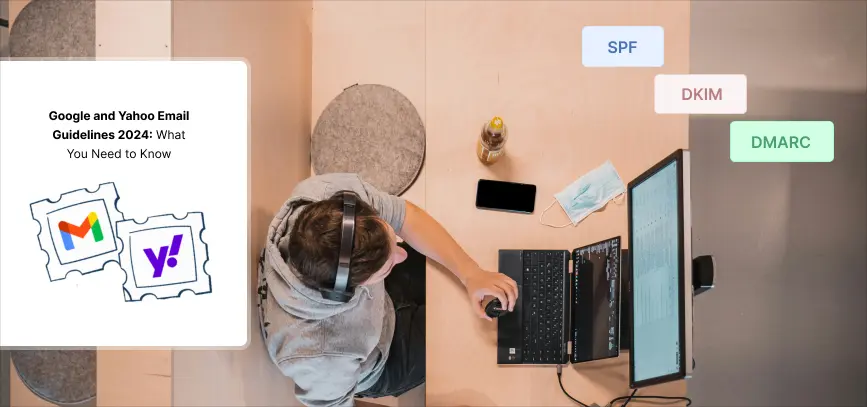
Google and Yahoo Email Guidelines 2024: What You Need to Know
Stay compliant with Google and Yahoo 2024 email policy updates. Improve email authentication, reduce spam, and simplify unsubscribes to boost results.
Google and Yahoo Email Guidelines 2024
Google and Yahoo Email Authentication Requirements
Strategies for Maintaining Low Spam Rates
How to Simplify Unsubscription Processes
Technical Details for Compliance with New Guidelines
How to Adapt Google and Yahoo's Email Policy Changes
Frequently Asked Questions About Email Guidelines
Conclusion: 2024's Google and Yahoo Email Policy Updates
In 2024, Google and Yahoo email policy updates are introducing stricter standards to enhance email security. These updated guidelines are particularly crucial for those who manage large volumes of email, specifically over 5,000 emails per day. Key changes include new email authentication requirements and comprehensive opt-out mechanisms to ensure that only verified and desired emails reach users' inboxes. Complying with the Google and Yahoo Email Guidelines 2024 is vital for email marketers aiming to improve their delivery rates and engage their audience more effectively.
Google and Yahoo Email Policy Updates 2024
TL;DR: New Email Policies Effective February 2024
Enhanced Certification Requirements
: SPF, DKIM, and DMARC records are now mandatory.
Unsubscribe Links:
Users must click on unsubscribe links once.
Spam Rate Thresholds:
New thresholds for spam rates have been set.
New Sender Requirements:
To improve email delivery, a new sender designation is required.
Email Authentication for Google and Yahoo Compliance
Email authentication is vital for verifying the legitimacy of your messages and protecting against phishing and spoofing. The updated guidelines emphasize three main mechanisms:
Sender Policy Framework (SPF)
SPF helps prevent domain spoofing by allowing senders to specify which email servers are authorized to send emails from their domain. This is a key part of compliance with Google and Yahoo email policy updates to ensure safe and authenticated emails.
DomainKeys Identified Mail (DKIM)
DKIM builds a digital signature for outgoing emails. This signature verifies that the message has not been altered during transit and confirms that it originated from an authorized sender. Implementing DKIM involves adding a DKIM signature to the headers of your emails and publishing the public key in your DNS records. DKIM adds reliability by protecting email content during transmission, enhancing security and delivery.
Domain-based Message Authentication, Reporting, and Conformance (DMARC)
Domain owners can designate what happens when an email fails authentication checks (SPF or DKIM) with Domain-based Message Authentication, Reporting, and Conformance. It also provides reports to give visibility into authentication outcomes, aligning with Google and Yahoo email compliance guidelines.
To comply with these requirements, bulk senders must implement SPF or DKIM and set up DMARC for their sending domains.

Strategies for Maintaining Low Spam Rates
One significant change in the 2024 email policy updates is keeping low spam rates. Google requires bulk senders to keep their reported spam rate below 0.1% (1 spam report per 1,000 emails). This is monitored through Google Postmaster Tools. It is crucial to avoid reaching a spam rate of 0.3% or higher, as this can significantly impact your email deliverability.
Best Practices for Low Spam Rates:
- Send Relevant Content: Ensure that your emails are relevant and valuable to your recipients. Personalize content based on user preferences and behaviors to increase engagement.
- Segment Your List: Segment your email list based on user activity and preferences. Sending customised emails to certain audience segments can increase engagement while decreasing the probability of being flagged as spam.
- Monitor Engagement: Regularly monitor email engagement metrics such as open rates, click-through rates, and bounce rates. Remove inactive subscribers from your list to maintain a healthy sender reputation.
How to Simplify Unsubscription Processes
Google and Yahoo email changes 2024 emphasize making it easy for recipients to unsubscribe from your emails. Bulk senders must enable one-click unsubscribe and include both the List-Unsubscribe-Post and List-Unsubscribe headers in outgoing mails. These message headers should comply with both RFC 8058 (one-click unsubscribe) and RFC 2369 (mailto unsubscribe) standards.
A simple unsubscription process can increase open rates, conversion rates, and overall sending efficiency. It also helps to maintain a positive sender reputation by reducing the likelihood of recipients marking your emails as spam
Technical Details for Compliance with New Guidelines
To ensure Google and Yahoo compliance with the new guidelines, here are the technical details you need to address:
Google's Email Compliance Requirements:
- Bulk Sender Definition: Bulk Sender Definition: Sending more than 5,000 emails to Gmail addresses inside a single day.
- Spam Rate Limits: Maintain a spam rate below 0.1%, avoiding 0.3% or higher.
- Unsubscribe Process: Enable one-click unsubscribe and include visible links in subscribed messages
- Authentication Protocols: Implement SPF or DKIM authentication messages for your domain.
- DNS Records: For transferring domains or IP addresses, ensure that the forward and reverse DNS records are valid.
- Message Formatting: Comply with RFC 5322's standard recommendations for message formatting.
- DMARC Setup: Set up DMARC email authentication for your sending domain.
- DMARC Enforcement for Gmail: To adhere to DMARC quarantine regulations, refrain from spoofing the From header on your emails.
- Forwarded Emails: Add ARC headers to outgoing emails if you forward emails frequently, and mailing list senders should include a List-id: header.
- DMARC Alignment: In order to undergo DMARC alignment for direct mail, make sure that it is aligned with SPF or DKIM domains.

Yahoo's Email Compliance Standards:
- Authentication Methods: Implement more robust authentication by using industry standards such as SPF, DKIM, and DMARC.
- Unsubscribe Process: Support one-click unsubscribe and process user requests within two days.
- Email Relevance: To keep an inbox clear of clutter, ensure that emails are relevant to consumers' choices.
Adapting to Google and Yahoo's New Email Policies
As an email marketer, it is essential to adapt quickly to these Google and Yahoo's 2024 email updates. Here are some steps you can take to ensure compliance and improve your email marketing strategy:
Strengthening Email Authentication
Implement and regularly update SPF, DKIM, and DMARC records for your sending domains. This not only helps in complying with the new guidelines but also protects your domain from spoofing and phishing attacks.
Simplifying Unsubscriptions
Make it easy for recipients to unsubscribe from your emails by including one-click unsubscribe links and supporting both List-Unsubscribe-Post and List-Unsubscribe headers.
Monitoring and Managing Spam Rates
Regularly monitor your spam rates and take proactive measures to keep them low. This includes sending relevant and engaging content, segmenting your email list, and removing inactive subscribers.
Frequently Asked Questions About Email Guidelines
How do I implement one-click unsubscribe?
Include List-Unsubscribe-Post and List-Unsubscribe headers in your emails, supporting both RFC 8058 and RFC 2369 standards.
What happens if my spam rate exceeds 0.3%?
Exceeding a 0.3% spam rate can lead to deliverability issues and potential blacklisting by email providers.
Why is email authentication important?
Email authentication helps in verifying the legitimacy of your emails, protecting against phishing and spoofing, and ensuring that your emails reach the intended recipients.
How can I monitor my spam rates?
You can monitor your spam rates using Google Postmaster Tools, which provide detailed insights into your email deliverability and spam rate.
Conclusion: 2024's Google and Yahoo Email Policy Updates
Adapting to Google and Yahoo's 2024 email policy updates is essential for maintaining effective communication with your audience. Ensure your emails are authenticated, keep spam rates low, and simplify the unsubscription process. By doing so, you will enhance your email deliverability and provide a better user experience.
For additional tips and best practices, explore our blog section on email marketing. Have some other questions? Let us help you navigate these updates and optimize your email marketing strategy. Reach out to us at support@mailzzy.com
Also read

Creative Valentine's Day Email Ideas to Capture Hearts & Boost Sales
Get inspired with 100+ creative Valentine’s Day email campaign ideas to engage customers, boost sales, and drive results this season.

Say Goodbye to Blasts with AI Personalized Email Marketing
Transform your strategy with AI Personalized Email Marketing. Learn how to replace mass emails with data-driven, personalized campaigns that truly connect.
Let's keep in touch
Sign up for our weekly email marketing newsletter and Mailzzy updates.
For more details, review our Privacy Policy








